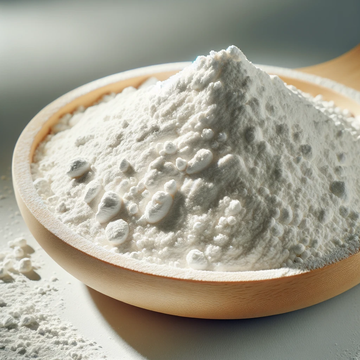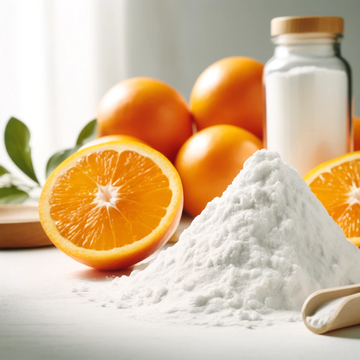Collagen, often hailed as the "glue" holding our bodies together, is more than just a buzzword in the health and wellness world. It's a crucial protein that provides structure and support to our skin, bones, muscles, and more. While collagen's importance is well-known among scientists and health enthusiasts, understanding its various types and benefits can be overwhelming for the average person.
What are the different types of collagen?
There are 28 different types of collagen that have been identified. These types of collagen are divided into different groups based on the structures that they form: Fibrillar and non-fibrillar. There are 5 main types of collagen: Type 1, Type 2, Type 3, Type 4, and Type 5.
Type I Collagen
Type I collagen is the most abundant protein in the human body and a vital component providing structural support and strength. It consists of three polypeptide chains wound into an incredibly strong triple-helix structure. This unique molecular composition allows Type I collagen to resist tensile forces and stretching.
In skin, Type I collagen accounts for 80-90% of the dermis layer, forming a network of fibrils that prevent wrinkling and sagging. It is also a major constituent of bones, giving them flexibility and fracture resistance by mineralizing with calcium. Moreover, Type I collagen is the primary component of tendons, ligaments and other connective tissues, enabling efficient force transmission and joint stability during movement. Its presence is crucial for wound healing, tissue repair and maintaining blood vessel integrity. However, collagen production declines with age, leading to skin aging, osteoporosis and joint issues if levels are inadequate.
Type II Collagen
This fibrillar collagen type plays a crucial role in the development and maintenance of cartilage tissues like articular cartilage in joints and the meniscus. In articular cartilage, Type II collagen fibrils provide tensile strength and resistance to compression forces, facilitating smooth joint movement. A deficiency in Type II collagen can lead to problems like arthritis, joint pain, and other soft tissue injuries. Type II collagen makes up about 50% of protein in cartilage and 85-90% in articular cartilage.
Maintaining healthy levels of Type II collagen is essential for cartilage function throughout life. However, cartilage lacks a blood supply, making it difficult to repair once damaged. New research shows that Type II collagen supplements can support cartilage regeneration after injuries. Our collagen supplement, Defense Drinks, uses Type II collagen, so it’s focused on reducing joint pain and facilitating smooth movement for your joints.
Type III Collagen
Type III collagen works alongside the super strong Type I collagen in various tissues throughout the body. This flexible collagen provides critical structural scaffolding and support in areas that need to stretch and bounce back, like hollow organs and blood vessels. It's a major component in blood vessel walls, contributing to their elasticity and ability to withstand constant blood flow. Type III collagen is also abundant in the dermis layer of skin, muscles, and the bowel.
During wound healing, Type III collagen initially forms a temporary matrix. This matrix is later replaced by stronger Type I collagen as healing progresses, resulting in a stable scar.
Adequate Type III levels are vital for maintaining the structural integrity of muscles, organs, and cardiovascular tissues subjected to mechanical stresses. For active individuals, having sufficient amounts helps prevent excessive tissue breakdown from strenuous training. Research explores using Type III collagen supplements to potentially aid recovery and tissue repair.
Type IV Collagen
Type IV collagen plays a different role than the structural fibrillar collagens like Types I-III. Instead of providing tensile strength, it forms critical sheet-like mesh structures known as basement membranes.
Basement membranes act as a foundation for epithelial and endothelial cells to attach and organize into layers that line various tissues and organs. Type IV collagen polymerizes into a cross-linked mesh that creates this scaffolding base.
You'll find Type IV collagen basement membranes underlying the skin's epidermis, surrounding muscle fibers, and lining the tiny blood vessels called capillaries. They also form the filtration membranes in the kidney glomeruli that allow waste to pass through while retaining blood cells and proteins.
Having intact, functional Type IV collagen membranes is crucial for tissue organization, filtration, and compartmentalization within the body. Defects or mutations can contribute to disorders impacting the kidneys, muscles, eyes, and even promote certain cancers by disrupting the basement membrane barriers.
Type V Collagen
Type V collagen is one of the minor fibrillar collagen types found in smaller quantities throughout the body. However, don't let its lower abundance fool you - it plays a crucial regulatory role when it comes to fibril formation and tissue organization.
The structure of Type V collagen features two α1(V) chains and one α2(V) chain woven into a triple helix. But here's where it gets interesting - these collagen molecules have a short triple-helical domain and a large globular section protruding from the helix.
Type V collagen doesn't form fibrils on its own. Instead, it gets distributed within the fibrils made up of the major Types I and III collagens in tissues like bone, cornea, placenta, and intervertebral discs. This strategic integration allows Type V to actually regulate the diameter and spacing of the stronger collagen fibrils.
Having the right ratio of Type V to fibrillar collagens is crucial for proper tissue development and function. Too much, and fibrils become thin and disorganized. Too little, and you end up with thick, irregular fibrils. This goldilocks balance is especially important in load-bearing tissues like bones and tendons.
Other types of collagen
- Type VI Collagen - Found in microfibrils that connect collagen fibrils to cells and other matrix components in many connective tissues.
- Type VII Collagen - Forms anchoring fibrils that secure the basement membrane to the underlying stroma in skin, mucous membranes, and amniotic membranes.
- Type VIII Collagen - Present in many basement membranes like those of the eye, kidney, and blood vessels.
- Type IX Collagen - Associates with surface of Type II collagen fibrils in cartilage to help interconnect them.
- Type X Collagen - Involved in calcification and remodeling of cartilage to bone during endochondral ossification.
- Type XI Collagen - Minor fibrillar collagen that co-polymerizes with Type II collagen in cartilage to regulate fibril diameter.
- Type XII Collagen - Forms bridge-like filaments that interconnect collagen fibrils in tissues like tendons and ligaments.
- Type XIV Collagen - Associates with fibril surfaces and plays an organizational role in connective tissues.
- Types XV and XVIII - Multiplexin collagens that associate with basement membranes and may regulate angiogenesis.
What are the benefits of collagen
Collagen can provide several potential benefits for active individuals and athletes:
- Joint Support: Types I, II, and III collagen are major components of ligaments, tendons, and cartilage. Supplementing with these may help support joint health and mobility, potentially reducing pain and risk of injuries. Specifically, Type II collagen makes up about 50% of cartilage protein. It may help reduce joint pain, symptoms of osteoarthritis, and rheumatoid arthritis by promoting cartilage integrity and modulating the immune system.
- Bone Strength: Type I collagen accounts for over 90% of bone's protein matrix, providing flexible strength. Adequate collagen intake may support bone mineral density and reduce risk of stress fractures.
- Muscle Recovery: Collagen contains high amounts of glycine and other amino acids involved in creatine production. This may aid muscle recovery, repair, and reducing exercise-induced inflammation. The amino acids in Type II collagen may also help rebuild and repair damaged cartilage after intense exercise.
- Skin Elasticity: Types I and III collagen provide structure and elasticity to skin. For active people prone to excess stretching, collagen may minimize stretch marks or sagging.
- Injury Repair: During healing, the body first lays down Type III collagen, later reinforced by Type I. Supplementation may expedite recovery from injuries like tendon/ligament strains. Type II collagen may facilitate cartilage regrowth after injuries by stimulating production of new extracellular matrix. Additionally, a blog post by Ideal Nutrition discusses how collagen supplementation can be beneficial for injury recovery.
- Lean Muscle Mass: Some research suggests collagen combined with resistance training may increase muscle mass and strength compared to whey alone.
For highly active individuals, maintaining healthy levels of collagen, especially Types I, II and III, is crucial for protecting joints from wear-and-tear, promoting mobility, preventing/managing osteoarthritis, and faster recovery from exercise and injuries involving connective tissues and cartilage.
How does collagen work?
Several things can affect how much collagen our body makes. Eating a balanced diet with enough protein and vitamin C helps fuel collagen production. A study conducted by Johnson et al. (insert year) found that vitamin C plays a crucial role in collagen synthesis, as it is necessary for the post-translational modifications that transform procollagens into mature collagen molecules.
Hormones, like estrogen, also play a role - they can boost collagen production. On the flip side, things like too much sun exposure or unhealthy habits like smoking can slow down collagen production.
Once collagen is made, it's constantly being broken down and replaced. Enzymes in our body break down old collagen, making room for new collagen to take its place. This turnover process keeps our tissues healthy and functioning properly.
Collagen is not just another health trend; it's a fundamental component of our bodies that impacts various aspects of our health and well-being. From supporting joint health to promoting injury recovery and enhancing skin elasticity, collagen plays a vital role in keeping us strong, flexible, and resilient. By understanding the different types of collagen and their respective benefits, as well as how collagen synthesis occurs and factors that influence it, we can make informed choices to support our overall health and vitality.





